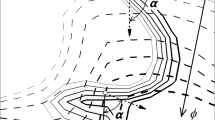Abstract
Current trend in design and operation of industrial gas turbines or internal combustion engines implies using the lean-fuel and stratified conditions aiming at the reduction of the harmful emissions and efficiency improvement. This has led to an increasing use of computational methodology, which allows detailed insight into combustion physics and processes controlling the emission formation. In the present work, the Darmstadt stratified burner is investigated by means of Large Eddy Simulation, implemented into the in-house, finite-volume-based numerical code FASTEST. The code solves the incompressible, variable-density Navier–Stokes equations coupled with the species transport equations. It is parallelized via domain decomposition technique using message passing interface (MPI). The complex chemical mechanisms are described by tabulated detailed chemistry utilizing the Flamelet Generated Manifolds (FGM) approach combined with the Artificially Thickened Flame model (ATF). The results obtained are comparatively assessed along with the complementary measurements. In-depth analysis of the flow field is conducted based on numerical simulations. Further studies have been carried out with respect to grid resolution and scalability.











Similar content being viewed by others
References
Boudier, G., Gicquel, L., Poinsot, T.: Effects of mesh resolution on large eddy simulation of reacting flows in complex geometry combustors. Combust. Flame 155(1–2), 196–214 (2008)
Charlette, F., Meneveau, C., Veynante, D.: A power-law flame wrinkling model for LES of premixed turbulent combustion part I: non-dynamic formulation and initial tests. Combust. Flame 131(1–2), 159–180 (2002)
Duwig, C., Fureby, C.: Large eddy simulation of unsteady lean stratified premixed combustion. Combust. Flame 151(1–2), 85–103 (2007)
Eindhoven University of Technology: Chem1d, a one-dimensional laminar flame code. http://www.combustion.tue.nl/chem1d
Germano, M., Piomelli, U., Moin, P., Cabot, W.H.: A dynamic subgrid-scale eddy viscosity model. Phys. Fluids A Fluid Dyn. 3(7), 1760 (1991)
Hager, G., Wellein, G.: Introduction to High Performance Computing for Scientists and Engineers. CRC Press, Taylor & Francis Group, Boca Raton (2010)
Hoefler, T., Dinan, J., Buntinas, D., Balaji, P., Barrett, B., Brightwell, R., Gropp, W., Kale, V., Thakur, R.: MPI + MPI: a new hybrid approach to parallel programming with MPI plus shared memory. Computing (2013). doi:10.1007/s00607-013-0324-2
Janicka, J., Sadiki, A.: Large eddy simulation of turbulent combustion systems. Proc. Combust. Inst. 30(1), 537–547 (2005)
Ketelheun, A., Olbricht, C., Hahn, F., Janicka, J.: Premixed generated manifolds for the computation of technical combustion systems. In: Proceedings of ASME Turbo Expo 2009, p. 11. Orlando, Florida, USA (2009)
Klein, M., Sadiki, A., Janicka, J.: A digital filter based generation of inflow data for spatially developing direct numerical or large eddy simulations. J. Comput. Phys. 186(2), 652–665 (2003)
Knüpfer, A., Brunst, H., Doleschal, J., Jurenz, M., Lieber, M., Mickler, H., Müller, M., Nagel, W.: The vampir performance analysis tool-set. In: Keller, R., Himmler, V., Krammer, B., Schulz, A. (eds.) Tools for High Performance Computing SE - 9, pp. 139–155. Springer, Berlin (2008)
Kuenne, G.: Large Eddy Simulation of Premixed Combustion Using Artificial Flame Thickening Coupled with Tabulated Chemistry. Optimus Verlag, Goettingen (2012)
Kuenne, G., Ketelheun, A., Janicka, J.: Assessment of isothermal and reacting LES when applied to a new premixed stratified burner. In: Proceedings of the European Combustion Meeting 2011, pp. 1–6 (2011)
Kuenne, G., Ketelheun, A., Janicka, J.: LES modeling of premixed combustion using a thickened flame approach coupled with FGM tabulated chemistry. Combust. Flame 158(9), 1750–1767 (2011)
Kuenne, G., Seffrin, F., Fuest, F., Stahler, T., Ketelheun, A., Geyer, D., Janicka, J., Dreizler, A.: Experimental and numerical analysis of a lean premixed stratified burner using 1D Raman/Rayleigh scattering and large eddy simulation. Combust. Flame 159(8), 2669–2689 (2012)
Legier, J., Poinsot, T., Veynante, D.: Dynamically thickened flame LES model for premixed and non-premixed turbulent combustion. In: Center for Turbulence Research, Proceedings of the Summer Program 2000, pp. 157–168 (2000)
Lehnhäuser, T., Schäfer, M.: Improved linear interpolation practice for finite-volume schemes on complex grids. Int. J. Numer. Methods Fluids 38(7), 625–645 (2002)
Lilly, D.K.: A proposed modification of the Germano subgrid-scale closure method. Phys. Fluids A Fluid Dyn. 4(3), 633 (1992)
Peters, N.: Turbulent Combustion. Cambridge University Press, Cambridge (2000)
Seffrin, F., Fuest, F., Geyer, D., Dreizler, A.: Flow field studies of a new series of turbulent premixed stratified flames. Combust. Flame 157(2), 384–396 (2010)
Smagorinsky, J.: General circulation experiments with the primitive equations. Mon. Weather Rev. 91(3), 99–164 (1963)
Smith, G.P., Golden, D.M., Frenklach, M., Moriarty, N.W., Eiteneer, B., Goldenberg, M., Bowman, C.T., Hanson, R.K., Song, S., Gardiner, W.C. Jr., Lissianski, V.V., Qin, Z.: Gri-mech 3.0. http://www.me.berkeley.edu/gri_mec
Vermorel, O., Richard, S., Colin, O., Angelberger, C., Benkenida, a, Veynante, D.: Towards the understanding of cyclic variability in a spark ignited engine using multi-cycle LES. Combust. Flame 156(8), 1525–1541 (2009)
Wegner, B.: A Large-eddy simulation technique for the prediction of flow, mixing and combustion in gas turbine combustors. Ph.D. thesis, TU Darmstadt (2007)
Zhou, G., Davidson, L., Olsson, E.: Transonic inviscid/turbulent airfoil flow simulations using a pressure based method with high order schemes. In: Fourteenth International Conference on Numerical Methods in Fluid Dynamics SE - 58. Lecture Notes in Physics, vol. 453, pp. 372–378. Springer, Berlin (1995)
Acknowledgments
The project is supported by the ‘Excellence Initiative’ of the German Federal and State Governments and the Graduate School of “Computational Engineering” and “Energy Science and Engineering” at Technische Universität Darmstadt. The authors acknowledge the financial support of the Numerical Simulation on the High Performance Computers (NuSim) project within subproject 2. The first author’s special thank goes to the Faculty of Mechanical Engineering at his home university in Sarajevo.
Author information
Authors and Affiliations
Corresponding author
Additional information
Communicated by Gabriel Wittum.
Rights and permissions
About this article
Cite this article
Avdić, A., Kuenne, G., Ketelheun, A. et al. High performance computing of the Darmstadt stratified burner by means of large eddy simulation and a joint ATF-FGM approach. Comput. Visual Sci. 16, 77–88 (2013). https://doi.org/10.1007/s00791-014-0225-8
Received:
Accepted:
Published:
Issue Date:
DOI: https://doi.org/10.1007/s00791-014-0225-8




